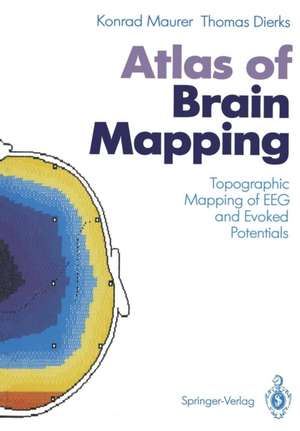Atlas of Brain Mapping: Topographic Mapping of EEG and Evoked Potentials
Autor Konrad Maurer, Thomas Dierksen Limba Engleză Paperback – 19 ian 2012
Preț: 360.14 lei
Preț vechi: 379.09 lei
-5% Nou
Puncte Express: 540
Preț estimativ în valută:
68.92€ • 73.69$ • 57.46£
68.92€ • 73.69$ • 57.46£
Carte tipărită la comandă
Livrare economică 17 aprilie-01 mai
Preluare comenzi: 021 569.72.76
Specificații
ISBN-13: 9783642760457
ISBN-10: 3642760457
Pagini: 120
Ilustrații: XI, 103 p. 11 illus.
Dimensiuni: 170 x 242 x 6 mm
Greutate: 0.2 kg
Ediția:Softcover reprint of the original 1st ed. 1991
Editura: Springer Berlin, Heidelberg
Colecția Springer
Locul publicării:Berlin, Heidelberg, Germany
ISBN-10: 3642760457
Pagini: 120
Ilustrații: XI, 103 p. 11 illus.
Dimensiuni: 170 x 242 x 6 mm
Greutate: 0.2 kg
Ediția:Softcover reprint of the original 1st ed. 1991
Editura: Springer Berlin, Heidelberg
Colecția Springer
Locul publicării:Berlin, Heidelberg, Germany
Public țintă
ResearchCuprins
1 Introduction.- 2 History.- 3 Definition and Terminology.- 4 Methodology.- 4.1 Introduction.- 4.2 General Conditions.- 4.3 Calibration.- 4.4 Electrodes.- 4.5 References.- 4.6 Baseline.- 4.7 Artifacts.- 5 Data Acquisition and Signal Analysis.- 5.1 Analog to Digital Conversion.- 5.2 Aliasing.- 5.3 Amplitude Mapping (Time Domain).- 5.4 Frequency Mapping (Frequency Domain).- 5.5 Map Construction (Spatial Domain).- 5.6 Map Features.- 5.7 Mapping of Evoked Potentials.- 6 Storing of Data.- 7 Statistical Procedures.- 8 Practical Application: Findings in Normal Subjects.- 8.1 Introduction.- 8.2 EEG Features in the Time Domain.- 8.3 EEG Features in the Frequency Domain.- 8.4 EP Features.- 8.5 EEG Mapping After Sensory, Motor, and Mental Activation and due to Psychotherapeutic Interventions.- 8.6 Sleep Features.- 9 Findings in Diseases.- 9.1 Introduction.- 9.2 Evaluation of EEG and EP Maps.- 9.3 Clinical Examples.- 9.4 EEG and EP Mapping During Normal Aging.- 9.5 EEG and P300 Topography in Dementia of Alzheimer Type.- 9.6 EEG and EP Mapping in Psychoses.- 9.7 EEG and EP Mapping in Clinical Psychopharmacology.- 10 Advanced Methods.- 10.1 Dipole Source Estimation.- 10.2 Neurometrics.- 10.3 Determining Differences Between Maps.- References.













